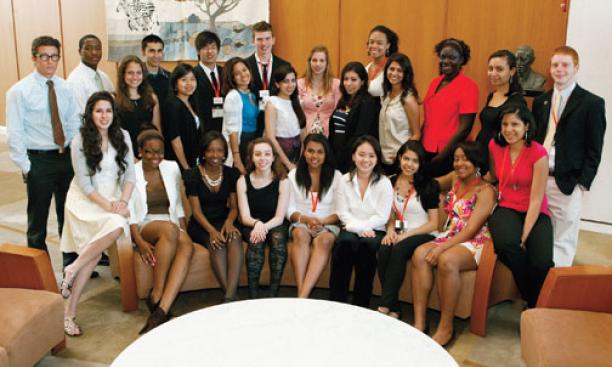

Secondary-school winners of the Princeton Prize in Race Relations came together with 80 Princeton-area high school students this spring in a Class of 1966-sponsored symposium meant to spark ideas for improving relations in the students’ communities.
The idea behind the Princeton Prize Symposium on Race Relations, which has been held for three years, “was to do something to give back,” said Bernard “Bud” D’Avella ’66. Classmate Henry Von Kohorn, who is now vice president of the Alumni Council (and a PAW board member), “stepped up and came up with something that resonates with everyone and has substance.”
On the first day of the symposium, held April 30 and May 1, the students attended workshops on topics related to multiculturalism. The next day, 26 winners of the Princeton Prize — which has been presented annually since 2004 and was awarded this year in 23 regions — gave presentations about their projects in Robertson Hall.
An enthusiastic crowd of students and alumni was particularly moved when high school senior Wei Chen was asked to redeliver in Chinese the address he had minutes before delivered in English. Chen moved from China to Philadelphia only three years ago, and as president of the Chinese American Student Association at South Philadelphia High School, he helped to bring national media attention to student violence targeted at 28 Asian students.
Chen himself was attacked twice, and seven of his peers were hospitalized. Still, disgruntled with the lack of a faculty response, he organized a nine-day boycott of classes until students were granted a meeting with the school district’s superintendent and promised heightened school security.
For their winning project, Hannah Birnbaum and Jenna Spencer, students at two private secondary schools in Boston, compiled an anthology of stories by peers about their experiences with racism. That book will be distributed to 250 independent schools in New England. David Joseph-Goteiner, a senior at a predominantly white private high school in San Francisco, and Terranisha Nathanie, a junior at a predominantly African-American high school in nearby Oakland, brought together students to fight “environmental racism” — the larger burden of pollutants and toxins in minority communities. Joseph-Goteiner’s classmates then created a movie about their work.
Other students helped diversity clubs rise to prominence within their schools. Some prepared independent studies on race relations in their neighborhoods, while still others spearheaded events to increase racial unity within schools.
Los Angeles students Chelsea Rae Dern and Bryson Rouzan Thomas noticed racial tension among girls who frequented the Jenesse Center, a shelter and support organization for victims of domestic violence, where the two students volunteered. To remedy that, they organized activities and wrote a puppet show inspiring children to learn about each other.
